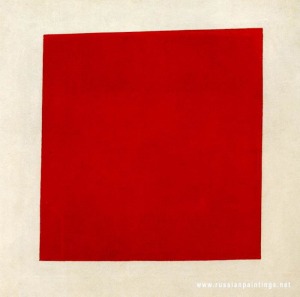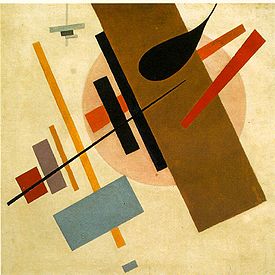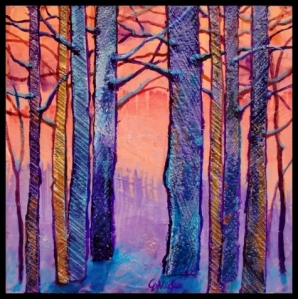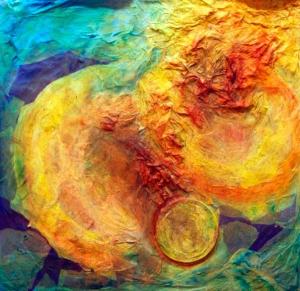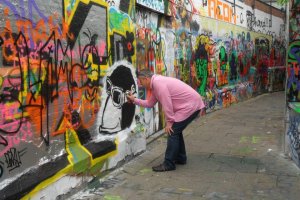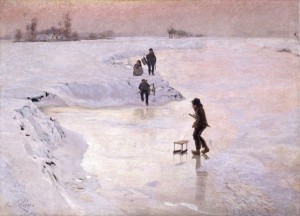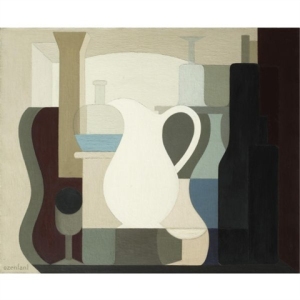Andrew Wyeth (1917 – 2009)
Andrew Wyeth was born in Chadds Ford, Pennsylvania, USA in 1917. Wyeth was the youngest of five children; his Father, Newell Covers Wyeth, was incredibly influential from an early age as he himself was a muralist and illustrator, illustrating scores of children’s classics over the years, so Andrew was incredibly privileged to have such a mentor so close at hand. Wyeth was taught to…
‘Avoid sentimentality…starkness never tolerates the sentimental way’. McCord (1970) p.13
Wyeth lived in Chadds Ford the whole of his life and his extended family still live in Chadds Ford in three eighteenth century fieldstone farm buildings which sit alongside the river. The complex of houses contains a gristmill, a house and apartment cum studio. Chadds Ford and especially the Brandywine River area was of strategic importance during the Revolutionary War, the British were billeted at Brandywine River, the river that flows alongside the Wyeth properties and the Americans were billeted only twenty miles away at Valley Forge. The Battle of Brandywine is a famous time within the war.
Wyeth’s work encapsulates his ‘world’, that of Chadds Ford and Maine. He wasn’t a great traveller and preferred to paint his surroundings, neighbours and his friends and family, his landscape paintings both in watercolour and tempera show country everyday life in every season, unromantic, hard and thought-provoking reality. His studies of trees, insects, animal’s and even rope and chains seen in the pencil drawing of 1956 of the same name, show how incredibly observant Wyeth was and in tune with his surroundings and neighbourhood. Wyeth hasn’t tried to romanticise country living, it is shown in the cold hard truth of hardship, hard work and at times especially during the late 1940’s onwards an impoverished society working to make ends meet. His honesty brings a real beauty to his work and although times were hard, in his portraits people’s ‘essence’ shines through displaying every emotion possible.
Wyeth’s first solo exhibition was in 1937 at the William Macbeth Gallery in New York, when Wyeth was just twenty years of age. The following year he exhibited again in Boston at the Doll and Richards Gallery, a lot of the works on show where watercolours of Maine. McCord (1970) describes Wyeth’s watercolour landscapes and portraits as showing, ‘a certain freedom and contagious quality of solitude and self-sufficiency’. Personally I find his works sensitive, dramatic, and some of his portraits hold a haunting torturous quality, all his work is honest, communicative and without sentimentality and to me breathtakingly beautiful.
Wyeth had a great love of costume and featured many garments such as coats and boots in his paintings, such as in The Patriot he uses a World War One uniform, in French Twist he uses a number of his wife’s coats and in Garret Room he paints a vibrant multi-coloured patchwork quilt. Wyeth had a tendency to use the same sitters/models on frequent occasions, this was due to him not enjoying travelling and also Wyeth felt inspired by certain places and people. The Helga pictures for example is a collection of drawings and paintings in both watercolour and tempera that stretch over a time frame of fifteen years, all the studies and paintings are of one subject: Helga Testorf, who was a German worker on Wyeth’s neighbours farm. Wyeth said of his relationship with Helga that it was strictly professional as with all his other models; however his marriage to his wife Betsy was put under strain after her discovery of the collection of work. Wilmerding (1987), states that the collection brings together a significant body of work over fifteen years by Wyeth showing a ‘fresh phase’ in the artist’s career. (p.7)
“The collection itself is, to my mind, a major extension – indeed another dimension of Andrew Wyeth’s achievement” Wilmerding (1987.p8)
Some of the most outstanding pictures within the collection in my opinion are maybe ones that are a little less obvious and wouldn’t necessarily be the choice of the critics. ‘In the Orchard’ is a beautiful watercolour with amazing detail, Helga is leaning against a tree wearing a fur hat, her green coat is pulled tightly around her and held tightly at her waist by a belt of the same colour, her hands are in her pockets as she stares out over the vista. The background in the painting just seems insignificant in detail but necessary to pull the viewer’s eye back into the foreground and to the main subject, Helga. In the same series of watercolours ‘In the Orchard’, in one painting Helga is leaning in the elbow of a tree this time the weather is less wintry and more spring like. The watercolour is split into three sections and the background in particular really interests me as the middle section has been left white and this is where Wyeth has painted the portrait of Helga, so she leaps forward from the page. The left of the background has been scratched and sponged to give texture and has had green and burnt umber washes added to the original pale burnt umber wash. The right hand side of the background is just a very pale burnt umber wash. Again within this series of work, Wyeth’s dry brush studies are amazing, in this particular painting where Helga is leaning in the elbow of the tree Wyeth has used dry brush to simulate the bark of the tree to amazing effect.
“I want to keep the quality of a watercolour done in twenty minutes but have all the solidity and texture of a painting” Quote by Wyeth in Wilmerding (p55)
Other paintings I love within the Helga Paintings are ‘Seated by a tree’, this is a haunting painting with an incredibly complex background of entwined trees and branches overlapping one another and blocking out a lot of the natural daylight in the orchard where it was painted. The directional light comes from the right hand side and highlights can be seen on the end of Helga’s nose, thighs and strands of hair. Helga is sitting leaning against a tree which she almost becomes a part of as it envelopes her into the background. The detail of the bark is exquisite and Wyeth has scratched out on top of the watercolour again to give texture and highlights.
‘The crown of flowers’, is a portrait of Helga wearing a crown of flowers, a close inspection of the way in which the flowers have been painted show how Wyeth has used the white paper ground as highlights and you can still see the under drawing on the crown, Wyeth’s belief was that using pencil didn’t detract from the painting it has its own quality so doesn’t compete. This portrait is a head and shoulders portrait of Helga and the highlights in the hair are what I like the most about the painting, they bring life to the whole face and they are incredibly delicate and I am guessing that masking fluid must have been used to add them. The background has no detail and is painted a matt black but this brings the focus completely to they face, hair and headdress. I have never tried this technique before of painting either directly onto a black ground or adding a black ground to a portrait; it’s something I will definitely explore in the future.
Wyeth’s use of light within his watercolour paintings and his use of texture within the medium is staggering. In his portrait Chester County, 1962; his subject is a man by the name of Tom Clark, Wyeth has painted his subject in profile and positioned him sitting slightly forward on his chair which means that the down pipe from the boiler almost sits on the man’s head like a crown. The room looks like an attic room, it is stark and the subject’s bed is seen in the background of the painting although it is neatly made it shows the coverlet to be patched and worn again providing the viewer with a taste of Tom Clark’s world. The sitter is painted showing no sentimentality and his face shows worry and even despair. The texture that has been achieved within the clothing is astonishing; you can visibly see the ingrained decay of the fabric. I can only imagine that the artist may have used a dry brush technique or stippling with masking fluid, I need to research his techniques further to try to find out how this was achieved. This is a wonderful portrait of an elderly man who has worry on his face but stories within his heart. Wyeth had previously painted several portraits and studies of Tom Clark, a head and shoulders portrait, named Tom Clark in 1956; Wyeth had visited the man at his lodgings in Chadds Ford and painted the man while he slept, again in a dry brush study Morning Sun in 1959 and again this time using Tempera in the painting That Gentleman in 1960. The later painting is named ‘That Gentleman’ as it is reported that Tom Clark would refer to all objects within his life, whether it was a pair of slippers, a car passing by or a fly buzzing round his head as ‘That Gentleman’. My favourite painting Wyeth did of Tom Clark is called Garret Room, 1962; it shows Tom lying on his bed on top of a multi-coloured patchwork quilt. Clark was over six-foot two inches tall and McCord (1970) reports that on seeing the portrait after Tom had died that same year, his daughter remarked that it had reminded her to call the funeral parlour to ensure that the undertaker made Tom’s coffin two inches longer so that he could be buried with his boots on.
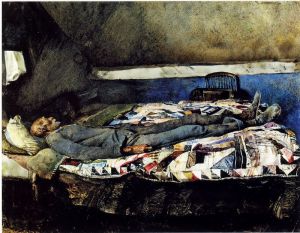
The Garrett Room
Frosted apples, 1967; a watercolour which depicts an autumnal scene, the scene is one of decay and the shutting down of life within the season. Wyeth’s use of texture within the painting especially on the tree bark makes the painting more like a photograph. As a viewer you are unsure as to which is the most important subject within the painting, is it the tree or is it the sack? The sack which is positioned leaning against the tree is half full of apples, or maybe some viewers will say half empty again Wyeth is allowing the viewer’s own story to travel into his painting, you will view it either optimistically or not.
Up in the woods, 1960 is a water-colour painted one snowy February day ‘up in the woods’ behind the Wyeth’s family home. Wyeth is reported to have loved white and painted many snowy days and scenes. The detail within this painting reminds me of being a child running through the forest close to my parent’s house, being chased by my younger brother; it also conjures up memories of pine cones that had been gnawed away by squirrels before they hibernate for the winter, that we used to find scattered on the forest floor. Another of my favourite snow scenes by Wyeth is The Dam, 1960. The snowflakes are falling over the water and you can actually imagine the cold wet sensation of the snowflakes falling onto the back of your neck as you stand looking at the water, watching the falling flakes being dissolved and disappearing into the inky black water of the dam.
Wash Bucket, 1963, is a painting that I don’t really like, although it is exquisitely executed and the bucket gleams out from the wall of the mill, the washes Wyeth has used on the walls I find to be slightly disturbing and it makes me wonder if this is a mill or if it is a slaughter-house. With the connotation of the painting being called ‘wash bucket’ I get an unease when viewing the painting, maybe it’s the juxtaposition of the shiny hard metal against the stone wall, the image brings sound memories back to me of nails being scratched down chalkboard which used to set my teeth on edge at school, viewing this painting gives me the same feeling.

Wash Bucket
Another repeated sitter for Wyeth was Willard Snowden. Snowden was of no fixed abode and Wyeth painted him several times. Snowden had walked into Chadds Ford looking for work in the winter of 1964 and had asked for work at Wyeth’s studio, Wyeth was immediately drawn to the man and the first painting of Snowden was called The Drifter in 1964, Snowden is looking down in the head and shoulders portrait as he was interested in watching Wyeth as he worked, I love the detail of the corduroy jacket Snowden is wearing it’s a wonderful contrast against his smooth skin. Monologue 1965 is another portrait of Snowden, this time sitting in a chair; the light from the window is shining on the right hand side of his face. The painting is apparently called ‘monologue’ because Snowden kept up a conversation whilst being painted, telling the story of his life, drifting from place to place. His hand is posed in such a way that you can tell a story is being told, it is not rigid and looks like it is being used to express the story unfolding. In 1966 Wyeth painted Grape wine, a portrait showing Snowden, but this time looking very different to his previous portraits, his features are a lot softer, you can see that his expression is happier and that he looks ‘fed and watered’.
I prefer Wyeth’s work which was undertaken in Chadds Ford, although his work in Maine was of the same outstanding quality and showed clarity and vision of people and places depicting everyday life, for me Wyeth excelled in capturing the landscape and the people he loved which comes through in his work from Chadds Ford, his childhood and Marital homeland. His skill in using watercolour washes to show depth, movement and texture in just one swish of his brush is incredible. I love the way Wyeth flicks his loaded brush at his paper and left splash marks which add to the ambience of the piece, I think this not only shows foresight and playfulness it also creates a sense of life being unfinished, not perfect, jagged around the edges and I would like to think that Wyeth embraced the ‘grey’ areas of life and didn’t have to have order or believe that life was black and white.
Bibliography:
Komanecky.M (2011) Christina’s World & The Olson House, Rizzolli International Publishers
McCord D. (1970), Andrew Wyeth, Museum of fine Arts Boston, New York Graphic Society
Wilmerding. (1987) Andrew Wyeth:The Helga Pictures, Harry N Abrahms inc.
Wyeth.B.(2001) Andrew Wyeth:Close Friends, University of Washington Press
